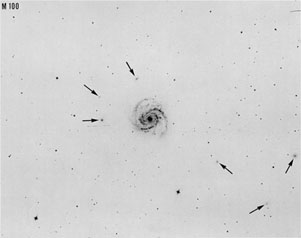


5.1 Elliptical Galaxies
E types are not illustrated because nearly all are structureless and
have similar appearance, showing smooth intensity distributions with
relatively steep gradients. Except for the presence of globular
clusters, detected in members of the Local Group
(Hubble 1932)
and in some of the nearby Virgo cluster ellipticals
(Sandage 1961
in the Hubble Atlas descriptions;
Vorontsov-Velyaminov 1966),
no resolved components of the stellar content are usually present brighter than
MV  - 3
(Baade 1944).
(NGC 205 is an exception where dust patches and a
few early-type stars begin to resolve at about MV = -4
[Baade 1951].)
- 3
(Baade 1944).
(NGC 205 is an exception where dust patches and a
few early-type stars begin to resolve at about MV = -4
[Baade 1951].)
E galaxies occur over a wide range of absolute luminosity extending
from MV = - 24 for the brightest members of clusters
of galaxies
(based on a Hubble constant of 50 km s-1 Mpc-1) to
fainter than MV = - 9
for dwarf ellipticals (dE) of the Sculptor Fornax type
(Shapley 1938a,
b;
Baade and Hubble 1939).
In addition to the
Sculptor (MV  - 13) and Fornax (MV
- 13) and Fornax (MV
 - 12) galaxies, other
low-luminosity ellipticals exist in the Local Group, such as M32
(MV
- 12) galaxies, other
low-luminosity ellipticals exist in the Local Group, such as M32
(MV  - 16.3), NGC 205 (MV
- 16.3), NGC 205 (MV  - 16.3), NGC 185 (MV
- 16.3), NGC 185 (MV
 - 15.1), NGC 147
(MV
- 15.1), NGC 147
(MV  -
14.8), Leo I (MV
-
14.8), Leo I (MV  - 11), Leo II (MV
- 11), Leo II (MV
 - 9.5), Ursa Minor
(MV
- 9.5), Ursa Minor
(MV  - 9),
and Draco (MV
- 9),
and Draco (MV  - 8.5). In addition, dwarf ellipticals are found as
companions to many giant galaxies of all types. A particularly good
example is NGC 4321 (M100) in the Virgo cluster which is surrounded by
at least six dE galaxies all fainter than MV
- 8.5). In addition, dwarf ellipticals are found as
companions to many giant galaxies of all types. A particularly good
example is NGC 4321 (M100) in the Virgo cluster which is surrounded by
at least six dE galaxies all fainter than MV
 - 15.
Plate 1 shows the
subclustering about the giant Sc as reproduced from a 100-inch plate.
Similar dE galaxies have been found in the Virgo cluster
(Reaves 1956),
in the M81 group
(Sandage 1954),
and in the Fornax cluster
(Hodge 1959,
1960).
The dE galaxies together with dwarf spirals and
low-luminosity Im are undoubtedly the most frequent type of galaxy per
unit volume of space
(van den Bergh 1959;
Holmberg, chap. 4 of this
volume), although they form a totally insignificant fraction of
catalogued galaxies to a given apparent magnitude because of their
exceedingly low absolute luminosity. Indeed, it has only been since
about 1940
(Baade 1944;
Wilson 1955)
that the dE galaxies have been recognized as a class.
- 15.
Plate 1 shows the
subclustering about the giant Sc as reproduced from a 100-inch plate.
Similar dE galaxies have been found in the Virgo cluster
(Reaves 1956),
in the M81 group
(Sandage 1954),
and in the Fornax cluster
(Hodge 1959,
1960).
The dE galaxies together with dwarf spirals and
low-luminosity Im are undoubtedly the most frequent type of galaxy per
unit volume of space
(van den Bergh 1959;
Holmberg, chap. 4 of this
volume), although they form a totally insignificant fraction of
catalogued galaxies to a given apparent magnitude because of their
exceedingly low absolute luminosity. Indeed, it has only been since
about 1940
(Baade 1944;
Wilson 1955)
that the dE galaxies have been recognized as a class.

|
Plate 1. M100 with six of its many dwarf elliptical companions marked. The spiral is of luminosity class I and is one of the brightest galaxies in the Virgo cluster. Many dE galaxies are spread throughout the area (Reaves 1956). From a plate taken with the Mount Wilson 100-inch reflector. |